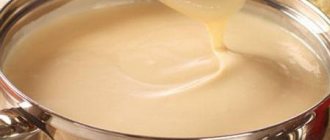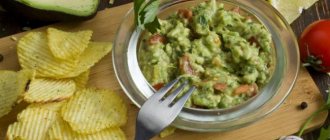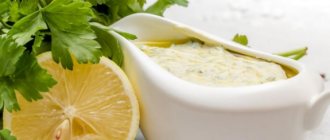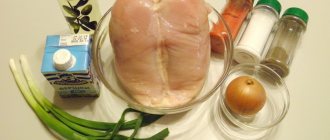Salsa - a sauce with a “dancing” name and spicy taste
It is known that in the 14th-15th centuries, the preparation of salsa was practiced by the Aztecs, whose diet was dominated by tomatoes and hot chili. To add a special taste and aroma, they mixed vegetables with beans and squash seeds. To make traditional Mexican salsa, you needed two tools: a mortar and pestle. Today, a blender or food processor is used to speed up the process, but chefs say that real salsa can only be made by chopping all the ingredients by hand.
There are several varieties of the popular Mexican seasoning:
- salsa roja - red sauce with a sweetish taste; Tomatoes are used for cooking, with spices added to taste;
- salsa verde - green sauce made from chili peppers, mint leaves, onions, garlic, cilantro; the mixture is seasoned with olive oil;
- salsa cruda - a sauce that contains onions, garlic, lime, cherry tomatoes and olive oil.
There are many national characteristics of salsa preparation. For example, Italians add anchovies, capers and coarse mustard to traditional ingredients, but the French like the spicy taste of herbs - dill, sage and tarragon wormwood (tarragon herb). Some people add peaches, mangoes, pears, strawberries and even sweet corn to the sauce. The general method of preparation is finely chopped greens, seasonings, favorite fruits, and the aromatic salsa is ready. Today you can find a wide variety of exquisite delicacies. In America, salsa is often used instead of ketchup.
See on topic: Mexican Guacamole dip
What is known about salsa sauce?
The first sauce recipes came to Europe from the Spanish conquerors of America; salsa was prepared by the Indians from the products available to them. Therefore, the dressing often included not only physialis and jalapeno, but also feijoa berries, guavas, pumpkin seeds and other components unusual for our area.
In Europe, the sauce was prepared from available Mediterranean products, so the recipe began to quickly transform. And in the modern world, where eclecticism triumphs and all the cuisines of the world are mixed in a single celebration of taste, salsa is not at all similar to the original version.
Today, sweet and sour syrups, fruits and berries are added to the sauce. Since the dressing is an excellent marinade, it boldly plays with combinations of acid, heat, salt and sweetness.
In Mexican cuisine, the sauce is considered universal; it is served on quesadillas, tacos, nachos and sandwiches. In European recipes it is used with pasta, fried meat and stewed vegetables.
Here's what you usually eat with salsa:
- barbecue and kebabs;
- rolls with meat, beans and vegetables, wrapped in a flatbread;
- stewed vegetables: bell peppers, celery, broccoli, potatoes, green beans, spinach, eggplant;
- roast;
- chips and bread;
- fish cakes;
- pasta, spaghetti, ravioli and other dough dishes, including those with meat;
- sausages;
- fresh vegetable salads.
Like many other dishes, Mexican sauce largely replicates tomato dressings from other cuisines of the world, therefore, in order for the salsa not to lose its flavor, typical ingredients must be added to it: hot peppers, lime juice, wild onions. In a broad sense, salsa can be understood as any hot sauce with tomatoes and peppers.
Health benefits of Mexican sauce
Salsa is considered the best way to maintain beauty, health and good mood. Due to its low calorie content, the sauce is often used in dietetics.
Mexicans, who have a cheerful and positive disposition, consider salsa an ideal cure for depression, as the sauce stimulates the production of “happiness hormones” endorphins.
Mexican Salsa sauce has a beneficial effect on the human body. People who consume the spicy dressing improve their appetite, normalize digestion, strengthen their memory, and the beneficial substances contained in chili peppers prevent the development of cancer and microbes.
Lifehack for housewives!
It is important to consume the sauce raw, since in this form the vegetables better retain their aroma, piquant taste and vitamin qualities.
Italian salsa verde recipe
Ingredients
- 1 small bunch of parsley.
- 1 lemon (whole zest, tablespoon juice).
- 15 green olives.
- 1 tablespoon capers.
- 0.5 cups olive oil.
- 1 clove of garlic.
- 0.5 teaspoon sea salt.
- freshly ground black pepper.
Cooking technology
- Chop the washed greens.
- Coarsely chop the olives and capers.
- Chop the peeled garlic, add salt, and crush it with a knife laid flat.
- Place all the ingredients in a chopper or blender bowl, grate the zest from the lemon into it, and squeeze out the juice.
- Grind, leave to brew. Let the components exchange aromas, tastes, moods. This way the flavor of the sauce will develop better.
Notes
- Green onions, cilantro, marjoram, basil, sage, mint, tarragon, savory leaves, thyme, chervil, rosemary - any combination of fresh herbs is allowed. They can replace some of the parsley or use it instead.
- Italian green salsa can amazingly transform and make expressive the taste of ordinary boiled, baked or stewed fish, meat, poultry, and unleavened vegetables. Spread on bread, it makes a wonderful snack.
- A few anchovies, onions, unripe gooseberries. How do you like the idea of adding such ingredients?
Classic recipe Salsa sauces
The piquant addition, despite its pungent taste, has taken root perfectly in our homes. Many housewives have modified the traditional recipe, diluting the main ingredients with cucumbers, radishes and radishes. In general, salsa is a dip, and its main purpose is to highlight the taste of the dishes with which it is served. Salsa goes well with tortillas, tortillas, tacos, and chips. So, if you decide to make salsa sauce yourself, the classic recipe includes the following ingredients:
- 2 onions;
- 0.5 kg of tomatoes;
- a bunch of parsley;
- 1 tsp. salt;
- 2 tbsp. l. natural lime;
- chili pepper - at your discretion.
Secrets of making salsa:
- Remove the skins from the tomatoes and puree in a blender.
Lifehack for housewives!
To remove the skin easily, immerse the tomatoes in hot water for 8 minutes, after making cuts at the base. Then they douse it with water and remove the skin.
- Peel the onion and chop.
- Wash the greens. Finely chop and add to the tomato mass.
- Pour in spices (usually coriander or ground pepper is used). Stir well.
- Add chili. Remember: salsa should have a spicy, fiery taste.
- Lime juice can be replaced with lemon concentrate, but the sauce will be more refined with a fresh citrus plant.
- At the very end, you need to thoroughly mix all the ingredients and add salt.
Video of making classic salsa:
Lifehack for housewives! The flavorful salsa can be served almost immediately, but if you let it sit, the taste will only get better.
Recipes for home cooking
Let's first prepare salsa roja - its classic recipe at home is not difficult to reproduce, but the process is not entirely ordinary. We will not boil the vegetables, but bake them and then mix them.
Red salsa (roja)
Ingredients:
- Tomatoes - 3 pcs. The meatier they are, the better.
- Onion - 2 pcs. medium size.
- Garlic - 5 cloves.
- Red hot pepper - 1 or 2 pods.
- Cilantro - 3 tbsp. l. chopped greens.
- Dry pepper pieces (regular red or smoked chili) - 1 tsp.
- Salt - to taste.
How to make red salsa at home:
- Turn on the oven to preheat. If you have a grill or grill with a grate, you can light it.
- We cut the tomatoes in half, peel the onions and also cut them in half. We don't peel the garlic.
- Place vegetables, cut sides up, and garlic on a baking sheet or grill grate.* The oven temperature should be about 180 °C. Bake everything for about 15 minutes. If we use a grill or barbecue, the tomatoes and onions need to be turned over several times during this time.
- Pour dry pepper into ⅓ tbsp. boiling water and leave for 15 minutes.
- We remove the hot peppers from stalks, seeds and membranes, then cut them lengthwise into two parts. Wrap in foil and place with other vegetables on a baking sheet/rack - they should remain there for about 10 minutes.
- After the allotted time has passed, we take out the baked vegetables - scorch marks should appear on their surface (with the exception of hot peppers).
- Place everything in the blender bowl as is, without removing the burnt layer. Just peel the garlic. We also send cilantro + soaked dry pepper there along with water + salt.
- Grind everything well, but not into a paste, but so that the texture of the vegetables and herbs is preserved.
- We taste the sauce for salt and, if necessary, adjust it to taste. Done, ready to serve!
*If we bake on a wire rack, you will have to place a metal plate or a small frying pan for the garlic.
We also recommend: Bolognese sauce
Pico de gallo
This is the simplest thing you can think of - no more difficult than making a summer tomato salad.
Ingredients:
- Tomatoes - 3 pcs. average.
- Onion - 1 pc. average.
- Hot pepper* - to taste. Whether the salsa is spicy or not is up to you.
- Cilantro - 4 sprigs.
- Lemon or lime juice.
*In the original it is serrano or jalapeno, but if you can’t find one, you can take any available hot one. Preferably some kind of meaty variety, with thicker walls.
How to make salsa:
- Cut each tomato into two parts, remove the liquid center with seeds (a teaspoon). Place the halves cut side down on a plate and leave them there while you prepare the rest of the ingredients.
- Peel the onion and cut into small (but not smaller than 3x3 mm) cubes.
- We remove the hot pepper from the stalk, seeds and membranes, and then cut it into cubes the same size as the onion.
- We tear off the cilantro leaves from the branches and chop them with a knife. We throw away the branches.
- Let's return to tomatoes. We pour out the moisture that leaked from them onto the plate - we don’t need it. Cut the tomatoes themselves into cubes approximately 10x10 mm.
- In a salad bowl or small bowl, combine all the vegetables and herbs, add salt and add lemon or lime juice - 1-2 tbsp. l., depending on the acid level of the tomatoes.
- Mix everything carefully, taste, if necessary, adjust to taste with salt and acid. You can serve it on the table!
Please note: the tomatoes for this salsa need to be strong, with dense pulp that will not release an excessive amount of juice. If you go shopping at the market, then ask for the “sealing” varieties intended for canning - they are better suited than salad varieties.
Mexican Salsa verde
We will present an original recipe that involves the fruits of vegetable physalis. It is difficult to buy it in chain stores, but you can ask private traders in the markets.
Ingredients:
- Vegetable physalis - 750-800 g.
- Serrano or jalapeno pepper (or any hot one available) - 1-2 pods.
- Garlic - 2 medium cloves.
- Cilantro - 1 small bunch.
- Lime or lemon juice - 1 tbsp. l.
- Salt and sugar - to taste.
How to make salsa:
- We set the oven to heat up. If you have a thermometer, set the maximum possible temperature.
- We remove the covers from the physalis and use the tip of a knife to cut out the “butts” (they are hard). Cut each fruit in half.
- We free the pepper from the stalk, cut it lengthwise, clean out the seeds and remove the partitions.
- We simply separate the garlic cloves from the head, do not peel them.
- On a baking sheet previously covered with parchment or foil, place the halves of the physalis and pepper, cut sides down. We also send garlic there.
- Place the baking sheet higher, almost in the highest position. If there is an upper grill, turn it on. Bake the vegetables until they are lightly charred. This will take approximately 6-8 minutes.
- After the time has passed, remove the baking sheet from the oven and transfer all the vegetables (pre-clean the garlic) into a blender bowl. We also send cilantro, lime or lemon juice, and salt there.
- Grind everything until smooth, then taste the sauce and, if necessary, adjust it to taste with salt and acid, add sugar. Green salsa is ready!
Please note: you can eat green salsa as soon as it has cooled to room temperature. However, if you let it brew in the refrigerator for at least a couple of hours, the taste will develop and become richer.
Also recommended: Oyster sauce
Pico de Gallo Salsa Recipe
It turns out that "pico de gallo" means "rooster's beak." Such a funny name appeared because the sauce used to be eaten with three fingers, and some smart guy came up with an unexpected association. Making delicious seasoning at home is not a problem. Difficult to find appropriate ingredients. For example, hot peppers are much more common than green peppers, which give the dish its characteristic spicy flavor.
How to cook at home:
- 3 tomatoes;
- onion (red head);
- 1 lime;
- chili pepper (2);
- garlic (1 clove);
- olive oil;
- sugar, salt.
- Peel the tomatoes.
- Cut half the onion into cubes, add two pinches of sugar, one pinch of salt, and freshly squeezed lime juice. Add chopped garlic to the onion.
- Chop the tomatoes, put them in a separate container and let them brew.
- Remove seeds from chili peppers, chop and add to tomatoes.
- Mix all ingredients and add olive oil.
Pico de Gallo goes well with meat dishes and grilled fish. The savory dip will perfectly complement the taste of corn chips or homemade chips.
Composition and calorie content of salsa sauce
The standard composition of salsa sauce includes few ingredients, the main thing is that it contains the most ripe, red and juicy tomatoes, as well as hot chili peppers. Additional ingredients for preparing the dressing include onions, fresh cilantro, salt and sour lime juice.
Salsa comes from Mexico, where the sauce is usually called “Salsa Roja” because of its rich red color - this phrase translated from Spanish means “red sauce”.
According to the rules of traditional Mexican cuisine, salsa can be served in two variations: raw or boiled. The ingredients of salza sauce can be cut into both small and large pieces. Hot dressing, as a rule, is used not for serving as a sauce, but for preparing appetizers, main courses or other gravies.
The calorie content of salsa sauce per 100 g is 29 kcal, of which:
- Proteins - 1.5 g;
- Fats - 0.2 g;
- Carbohydrates - 6.7 g;
- Dietary fiber - 1.8 g;
- Water - 89.18 g.
Ratio of proteins, fats and carbohydrates: 1:0.1:4.5.
Vitamins per 100 g of product:
- Vitamin C - 4 mg;
- Vitamin B1 - 0.1 mg;
- Vitamin PP - 1.1 mg;
- Vitamin B6 - 0.1 mg;
- Vitamin A - 28 mcg.
Minerals per 100 g of salsa sauce:
- Calcium, Ca - 12 mg;
- Iron, Fe - 2.2 mg;
- Magnesium, Mg - 16 mg;
- Phosphorus, P - 30 mg;
- Potassium, K - 270 mg;
- Sodium, Na - 430 mg;
- Zinc, Zn - 0.2 mg;
- Copper, Cu - 0.1 mg;
- Selenium, Se - 0.4 μg.
On a note! One teaspoon contains 6 g of salsa sauce, and one tablespoon contains 25 g.
salsa verde sauce
The “green” version of the famous Mexican dressing is salsa verde. To prepare it, instead of ripe tomatoes, unripe tomatoes are taken. This sauce is based on traditional salsa and was invented by enterprising Italians. With their light hand, the seasoning became less spicy and acquired an unusual green tint.
Ingredients:
- 4 milky ripe tomatoes (green, but edible tomatoes);
- 4 cloves of garlic;
- 2 chili peppers;
- half an onion;
- 500 ml chicken broth;
- spices (bunch of cilantro, oregano).
- Wash the tomatoes, peel them, place them in a container with chicken broth, and boil.
- Cut the chili into large strips and add to the broth along with garlic and chopped onion. Boil.
- Place the sauce ingredients in a blender, add salt and pepper. Add cilantro, oregano.
How to make Salsa Sauce
Ingredients:
Cut the tomatoes into small cubes. Drain the juice and place in a bowl.
Mix garlic, cumin, pepper and salt with tomatoes.
Roughly chop the cilantro and add it to the salsa.
Squeeze the juice from half a lemon. Add the remaining ingredients and mix well.










